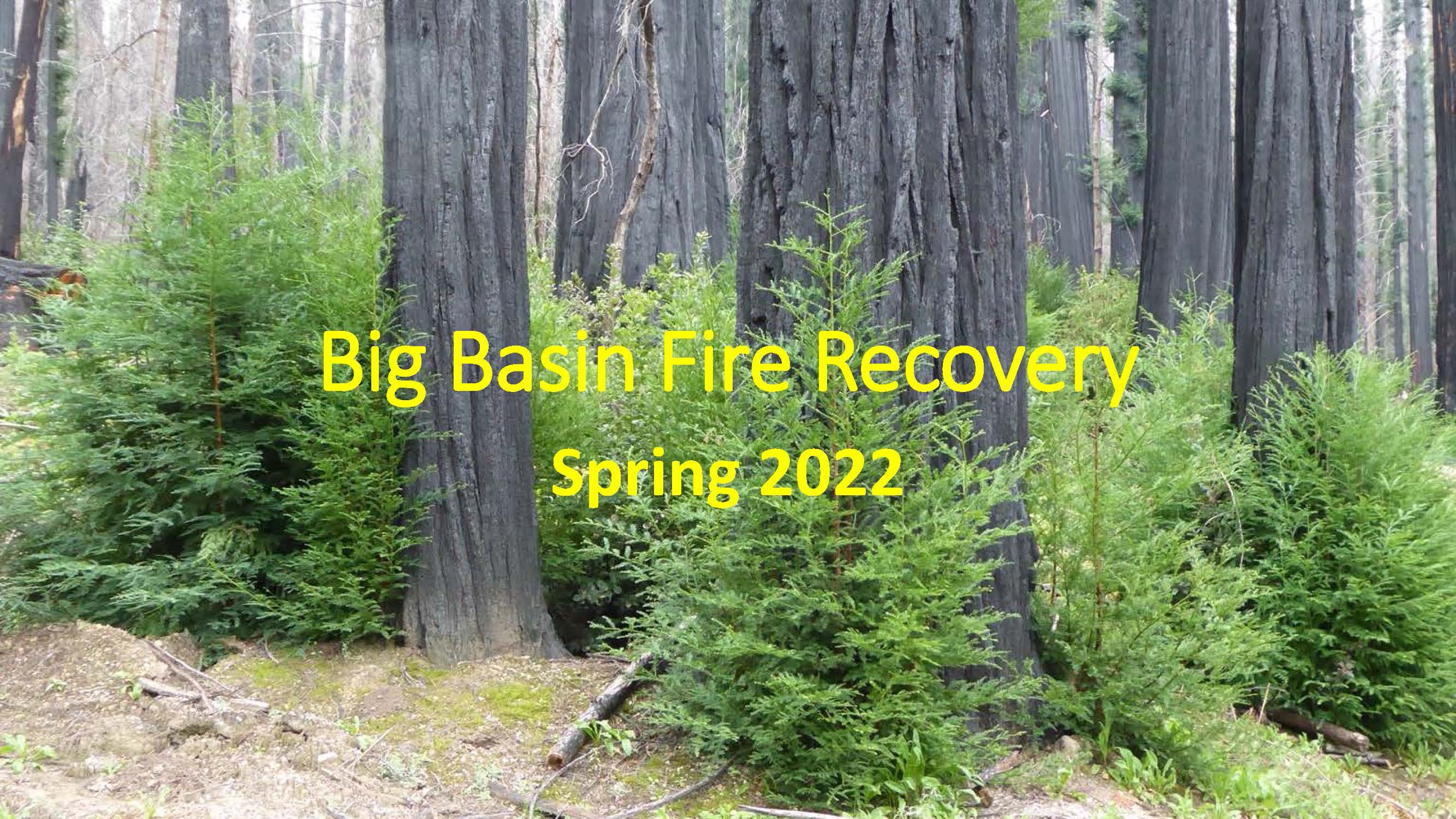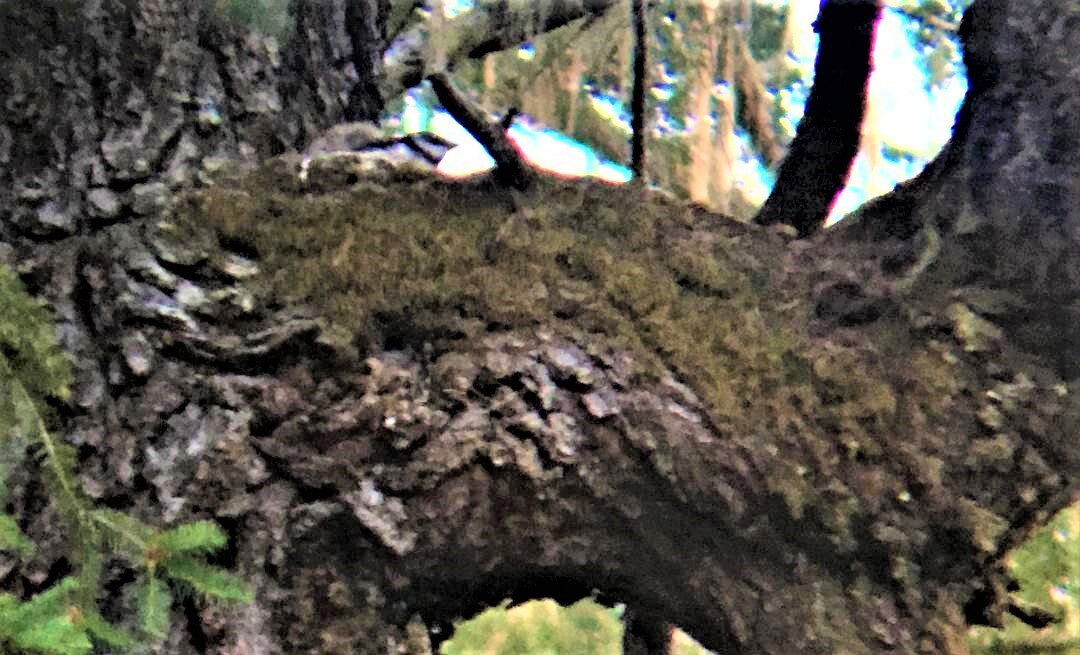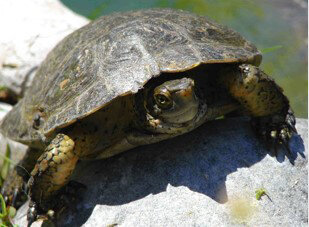in case you missed them… Our 2023 and 2022 Scientific Research Virtual Symposia on Post-fire Recovery in Big Basin State Park Can be Accessed Below
April 2024 — New Information about the 2020 Big Basin Fire
Click on captions to view larger photos
From left to right: (1) Thorough coverage of the burn within the fire perimeter left few refuge areas where wildlife could survive (5-21-22). (2) On old-growth trees most large branches were burned away, removing the suitable nest sites used by marbled murrelets (6-18-22). (3) Hillside near Sempervirens Campground (6-2-22). (4) Loss of tree canopies allowed sunlight to reach the forest floor and sun-loving plants to replace the normal redwood flora (9-25-23).
Bioregional Council board member and forest biologist Steve Singer prepared a new presentation that reveals some of the effects of the fire on the park ecosystem that have not been widely reported in the media. Called “The 2020 Big Basin Fire – The Untold Story” it discusses the underlying cause of the fire and actions that we can take to reduce the likelihood of future fires of this extreme severity. It can be seen here.
About the Bioregional Council
The Santa Cruz Mountains Bioregional Council is a public benefit non-profit corporation administered by biologists and natural resource professionals on a voluntary basis. We are the only organization in the Santa Cruz Mountains whose sole purpose is to protect native biodiversity throughout the entire Bioregion and to promote the science-based, sustainable use of our natural resources.
Most recently we have been focusing our attention on the 2020 CZU Lightning Complex Fire and human-induced climate change. That fire burned 97% of Big Basin State Park and was a fire of unprecedented severity. We present post-fire park research findings below. Elsewhere on this website are recommendations for management of Big Basin after the fire, progress reports on forest recovery, and many photos showing fire damage done to the park.
The 2020 fire was the first climate-change megafire to burn an old-growth coast redwood forest, but we fear it might not be the last. Some simple but important steps you can take to fight climate change are provided further down this home page.
We join with other local scientists in sounding the alarm about the looming world-wide catastrophe if humankind doesn’t take stronger steps to slow and then reverse the levels of greenhouse gases in our atmosphere. Dr. Gary Griggs, Distinguished Professor of Earth Sciences at the University of California – Santa Cruz, and an expert on climate change, presents some alarming facts about the worldwide impacts of global warming and urges us all to take prompt action. Read about it here.
Post-fire Research Findings in Big Basin State Park
Click on captions to view larger photos
From left to right: (1) Former deep pool on main stem of Waddell Creek now filled with sediment from the burn area; (2) Basal sprouting of redwood two months after the fire; (3) Ceanothus thyrsiflorus went from largely absent before the fire to abundant afterwards; (4) Marbled murrelet chick on a nest (photo by A. Rinkert); (5) Most of the park is still off-limits to the public while trails are being rebuilt and planning proceeds.
Two Symposia are now Available To View on YouTube:
2022 — 1st Symposium on Post-fire Research https://www.youtube.com/watch?v=Pe2c8TDSgK0
2023— 2nd Symposium on Post-fire Research https://www.youtube.com/watch?v=DtdmH3KCU8s
2022 Program Agenda:
(1:50) Introduction – Jen Michelsen, President, SCMBC
(5:10) Prescribed Burning Effects on Fire Severity – Sky Biblin, SJSU
(23:17) Post-fire Response of Redwood Flora – Mojgan Mahdizadeh, SJSU
(36:58) Fire & Fungi in the Santa Cruz Mountains – Christian Schwarz
(56:53) Fire & Soil Microbial Communities – Caroline Daws, Stanford Univ.
(1:14:56) Fire Impacts on Breeding Hermit Thrush – Allison Nelson, Gold Country Avian Studies
(1:36:02) Mammal Recovery After the Fire – Kristy Doerr, SJSU
(1:46:22) Fire Impacts to Coastal Gazos and Waddell Creeks – Jerry Smith, SJSU
A complete program agenda with full titles and speaker affiliations can be found here.
2023 Program Agenda:
(3:00) Introduction – Jen Michelsen, President, SCMBC
(6:30) Status of Fish, Frogs, & Habitat on Coastal Waddell Creek – Jerry Smith, SJSU
(35:43) Old Carbon Stores Fuel Redwood Sprouts – Drew Peltier, Univ. Nev.- LV
(57:27) Post-fire Ceanothus Invasion of Redwoods & Threats to Knobcone Pines – Jon Keeley, USGS, UCLA
(1:18:42) Fire: Initial Impacts on Breeding Birds – Alex Rinkert, consulting biologist
(1:37:21) The Future Park – Reimagining Big Basin – Will Fourt, Calif. State Parks
A complete program agenda with full titles and speaker affiliations can be found here.
Figures from left to right: 1. Bizarre sprouting of new branches from redwood. 2. Over 3,000 hazardous trees were cut down after the fire. 3. Biggest tree in the park had its top-half blown off by the fire. 4. Two years after the fire, Western Morning Glory (Calystegia purpurata) drapes itself over other vegetation.
Five Things That You Didn’t Know About the 2020 Big Basin Fire… And Need to Know
Click on captions to view larger photos
The mature and old-growth redwood trees have mostly survived the fire and that is a very good thing. However, other plants and animals are not doing so well.
1. It was the hottest and most damaging fire to occur in Big Basin in all of recorded history. It was the first mega-fire to hit an old-growth coast redwood forest. By mega-fire, we mean a fire of such exceptional intensity that it would not likely have occurred if the variables that determine fire severity had not been altered by climate change. It is unlikely that the park will look the same in our lifetime.
2. Of the more than 3000 acres of old-growth redwoods in the park, only 9 small areas, totaling less than 100 acres, escaped the fire (1). Many hundreds of animals were killed by the fire. The lack of fire refuge areas means that re-population of the park by most smaller terrestrial wildlife species will be a very slow process.
3. An estimated 83% of the potentially suitable marbled murrelet nest trees in the park were destroyed by the fire, placing the future of this species in Big Basin in doubt (2). Eighty-five percent of Douglas-firs greater than 4 cm in diameter were killed by the fire (3). Although almost all old-growth redwoods survived by sprouting new branches, if only a few, the fire destroyed almost all the large branches in the canopy which provided nest sites for murrelets. Since the fire murrelet nesting behavior has only been observed in the few small green spots that did not burn.
4. There is now a dense growth of grasses, weeds, and shrubs on the forest floor that is not a normal part of the redwood forest plant community. The lack of tree canopy cover has allowed sunlight to penetrate to the forest floor changing the microclimate. What was once a shady, cool, and damp environment is now sunny, warm, and dry (4).
5. Douglas-firs are now very scarce in the park and will likely remain so. The dense plant cover on the forest floor has made it impossible for seedlings of redwood and Douglas-fir to establish themselves and grow in all but the few areas of the park where the tree canopy cover still exists and there is open ground below (5).
When native and non-native invasive species take over the forest floor they take away the space needed by native redwood forest species like these:
From left to right: Redwood Violet (Viola sempervirens), Redwood Sorrel (Oxalis oregana), Western Sword Fern (Polystichum munitum), Pacific Starflower (Trientalis latifolia), and Wake Robin (Trillium ovatum).
Considering the severe impacts listed above, it should be clear that we, as a society, and including our elected representatives, our government agencies, our land conservancies, and our private business enterprises, need to do all we can to reduce carbon emissions and thereby prevent future mega-fires from occurring. The cost of doing nothing is too high. A simple list of eight things you can do to help save the planet is provided below.
Sources: (1) Potter, C. 2023. Impacts of the CZU Lightning Complex Fire of August 2020 on the Forests of Big Basin Redwoods State Park, California Fish and Wildlife Scientific Journal 109:c1 (see October 2021 satellite imagery), (2) Singer, S.W. and A. Rinkert, in prep., Impacts of the CZU Lightning Complex Fire on Marbled Suitable Nest Trees in Big Basin State Park. Unpublished report for the Santa Cruz District, California State Parks. (3) Mahdizadeh, M. and W. Russell 2021. Initial Floristic Response to High Severity Wildfire in an Old-Growth Coast Redwood (Sequoia sempervirens) Forest, Forests 12, 1135, https://doi.org/10.3390/f10281135; (4) S.W. Singer, pers. comm.; and (5) M. Mahdizadeh, pers. comm.
NEW—2023 CZU Post-fire Survey of Waddell Creek by Jerry Smith
Jerry Smith re-surveyed fish and stream conditions in Waddell Creek in August of 2023 and found significant deterioration since 2022. Heavy winter rains falling on fire-denuded slopes caused significant sediment input to the channel that severely damaged fish habitat. Instead of showing recovery from the fire, channel conditions have actually gotten worse in this area. For more information, read his cumulative 2020 to 2023 report, well-illustrated with photos, that can be found at this link. The photos below provide a preview of what can be found in his new report.
Click on captions to view larger photos
Figures from left to right: 1. West slope of West Fork above stream — Dead redwoods and Douglas-firs occupy west slope with sparse groundcover (8-26-23). 2. West Fork — Former pool that was 130 feet long and 3+ feet deep completely filled with sediment over the last two winters. 3. West Fork — Dead trees on a burned slope that is now a major source of sediment to stream. 4. Main Stem — Log jam formed in 2023 from fallen alders. Jam created no pool and is not beneficial to fish.
Summary of CZU Fire Impacts Through 2022 on Waddell, Gazos, and Scott Creeks with Many Photos
Since 1992, Jerry Smith has annually sampled juvenile coho salmon and steelhead at the same index sites, including the same individual habitats when possible, in Waddell, Gazos, and Scott creeks. The 2020 CZU Fire blocked fish sampling that fall, but allowed him to assess the impacts of the fire on upslope, streamside, and channel conditions on Gazos and Waddell creeks in 2021 and 2022, and Scott Creek in 2022, and to also resume fish sampling on Gazos Creek in 2021 and on Waddell and Scott creeks in 2022.
On Waddell the fire impacts increased upstream of mile 2.6, and the streamside/riparian fire damage to Gazos and Scott creeks was less severe than on Waddell Creek. Erosion and sedimentation in the first winter after the fire were minimized by the mild winter, but the drought conditions delayed the recovery of shrub and herb ground cover until 2022. In October and December 2021 heavy rain on the unprotected slopes resulted in massive erosion, and heavy flood flows moved sediment throughout the watershed, filling pools even in downstream sites with little direct fire damage. October and December floods also moved channel wood and fire-toppled trees, producing potential fish passage log jams in narrow, entrenched channels on Waddell Creek and especially on Gazos Creek.
The 2022 slide show (with text), ‘Impact of the CZU Fire on Stream Habitat in the Coastal Portions of Gazos and Waddell Creeks’ can be found here. This presentation was part of our November symposium but had to be cut short, so the full information is presented here.
The combined October 2022 and 2021 Waddell Creek report can be found here.
The combined 2022 and 2021 Gazos Creek reports can be found here.
The 2022 channel assessment of Scott Creek can be found here.
The comprehensive report on juvenile coho salmon and steelhead in these 3 creeks from 2007 to 2022 can be found here. The findings have major implications for the long-term survival of coho and steelhead in the Bioregion.
Recommendations for Re-Imagining Big Basin
TO: Mr. Barney Matsumota, Chair, Big Basin Reimagining Planning Team
SUBJECT: Santa Cruz Mountains Bioregional Council (SCMBC) Comments on the Reimagining Big Basin Plan
The Santa Cruz Mountains Bioregional Council is pleased to endorse the recommendations on restoring, managing, and operating Big Basin State Park after the fire that have been prepared by the California State Park Rangers Association (CSPRA). Their April 17, 2022 letter containing the recommendations, all of which we support, is attached.
Below we have condensed and paraphrased the recommendations to make it easy for you to review them. See their letter for the full recommendations.
Recommendations for the Reimagining Big Basin Planning Effort
1. The Big Basin Redwoods General Plan should be used as a guide for management, including the provision to keep major use areas outside of the prime redwood areas.
2. New interpretive messaging is needed to indicate causes of mega-fires, how redwoods react to them, and how park managers can best respond.
3. The fire and subsequent hazardous tree removal work has created a much more open forest canopy which has allowed sunlight to reach the forest floor. This, in turn, has created a dense growth of grasses, herbs, and shrubs that pose a new weed spread and fire hazard problem that needs to be addressed.
4. Revegetation will be needed in some areas of the park. Those areas should be mapped and a native plant nursery created to provide suitable plant materials for use.
5. Remaining areas of suitable marbled murrelet nesting habitat should be mapped out and protected from disturbance.
6. The historic park headquarters building should be rebuilt in its original style but in a different location. It should be used for interpretation purposes and not as an operational headquarters.
7. Archeological surveys should be conducted throughout the park to expand our knowledge of indigenous people’s use of what has become the park.
8. The park infrastructure should be rebuilt and operated so as to minimize the carbon footprint and provide an example of how we as a society can reduce global warming.
9. Messaging should not understate the threat posed by megafires. The character and impacts of the 2020 fire went beyond “nature’s way of renewing the forest.” Understanding the limitations of even a robust prescribed burning program, under the altered conditions of global climate change, should be part of the interpretive message to visitors.
The Santa Cruz Mountains Bioregional Council (www.scmbc.org) is a public benefit non-profit corporation comprised of biologists and natural resource professionals. We are the only organization in the Santa Cruz Mountains Bioregion whose sole purpose is to support the science-based use and conservation of our natural resources.
Thank you for your consideration of our recommendations.
Jen Michelsen, President SCMBC
Big Basin Fire Recovery: Spring 2022
Big Basin’s second Spring after the fire reveals major changes to the forest landscape — Observations and photos by Steve Singer, Biologist, in this update.
SUCCESSFUL MURRELET NEST IN BIG BASIN — VIDEO of bird fledging from nest and article by alex rinkert — see below
Murrelet nestling in 2021 nest on very large branch. Bird is in its black-and-white plumage acquired just before fledging. Photo: Estrella Bibbey.
On July 9 at 8:55pm a nestling marbled murrelet hopped off a nest in Big Basin State Park and began its very first flight, which would take it seven miles to the Pacific Ocean.
The nest tree, an old-growth Douglas-fir, was in a tiny 9-acre stand that did not burn. It’s estimated that at least 50% of the suitable nest trees in the remaining 4,400 acres of old-growth forest habitat which did burn, were lost. What’s more, the old-growth Douglas — firs that murrelets prefer over redwoods for nesting — were preferentially killed by the fire.
Watch the murrelet fledging video produced by Frans Lanting for California State Parks (link here). Avian biologist Alex Rinkert discovered this nest and his account of the find and subsequent fledging of the young can be found here.
Read more about the status of Marbled Murrelets in the Santa Cruz Mountains (link here).
EARLIER REPORTS ON FIRE RECOVERY AT BIG BASIN
Follow this link to see the July 2021 report and park photos.
Follow this link to see the Spring 2021 park photos.
Follow this link to see the Fall 2020 park photos and to read “The Emptiness of a Devastated Landscape,” an essay by Steve Singer who was stunned by his first visit to Big Basin, two months after the fire.
POWER POINT SHOW ON COAST REDWOODS AND FIRE
Associate Director Zane Moore, a UC Davis graduate student working on redwood genomics, prepared an excellent presentation on Coast Redwoods and Fire. He also focused on the fire’s impact on Big Basin State Park. It was prepared for the Santa Cruz City Museum of Natural History and is a little over one hour in length. Watch it here.
REDWOOD FOREST IMPACTS OF THE CZU LIGHTNING FIRE COMPLEX: Climate Change Hits Home with Catastrophic Results
The CZU Lightning Complex fire was an unprecedented fire event throughout all of recorded history for the Santa Cruz Mountains. Here we will report what happened, why it happened, and what it means. Although the fire burned many vegetation types, we will focus here on the redwood forest which comprised the bulk of the burn area. Read more here…
Scott Peden and colleague at the base of his namesake tree – the tallest tree in the Santa Cruz Mountains at 352 feet tall. The Scott Peden tree is the one in the photo with the divided top. For more about this remarkable tree and Scott, click here.
What is the Santa Cruz Mountains Bioregional Council and Why Does it Matter to You?
The Santa Cruz Mountains Bioregional Council is a non-profit public benefit corporation that serves the 7 million people who live or work in the greater Santa Cruz Mountains area which includes San Francisco, San Mateo County, the Santa Clara Valley, and Santa Cruz County. Our goal is to protect the quality of life for all who live or work therein and to maintain the health and productivity of the natural resources found within this area. We do this by promoting the use of scientific findings (facts not fake news) to maintain our region’s clean air, clean water, productive soils, and sustainable forests and woodlands. These attributes that we all enjoy are the product of healthy natural ecosystems and their supporting compliment of diverse and abundant native plants and animals.
Governing the Council is a nine-member Board of Directors comprised of biologists and other natural resource professionals whose objective is to conserve native plant and animal biodiversity in the Santa Cruz Mountains Bioregion.
Other Important but Older News
Winter 2020 – Monarchs…. Going, Going, Gone?
Alarmingly, Monarch numbers have decreased by 99% since 1980 and they are facing possible extinction. Losses during their overwintering stay here in our Bioregion are a significant factor in this decline. We now rate them as being at risk of extirpation in the Bioregion. Read more here…
June 2020 — List of Animals at Risk has been Updated
The list of animals at risk of extirpation in the Bioregion, also known as “sensitive species”, was revised in June 2020. The original list was created in 2003. Since then better or new information has required that some species or subspecies be added to the list (Bald Eagle, Mountain Quail, Long-eared Owl, San Francisco Common Yellowthroat, Alameda Bay Song Sparrow, Monarch Butterfly, and Crotch Bumble Bee) and allowed a few species to be deleted from the list. There are currently 99 species or subspecies at risk of extirpation in the Bioregion. These include 13 mammals, 10 reptiles, 7 amphibians, 8 fish, 35 birds, and 26 insects. The revised list can be seen here.
July 9, 2020 — Foothill Yellow-legged Frog Endangered Locally and Western Pond Turtles on the Decline
In March, the California Fish and Wildlife Commission listed the Foothill Yellow-legged Frog (Rana boylii) as endangered in the Central Coast Region, which includes the Santa Cruz Mountains Bioregion. This is the rarest frog that occurs in the Bioregion. Read more about the Foothill Yellow-legged Frog here.
The Western Pond Turtle (Emys marmorata) is currently under review for possible listing under the federal Endangered Species Act. For 25+ years Dr. Jerry Smith has studied a population at the mouth of Waddell Creek and has documented a dramatic decline in turtle numbers in the last 15 years, apparently due to a loss of nesting habitat; only older turtles are now present. This habitat is limited because they don’t nest on the damp or vegetated edge of a pond or stream. Instead the adults will travel ¼ mile or more to find an open sparsely vegetated area or fallow or unirrigated agricultural field in which to lay their eggs, and the soil must remain undisturbed until the following spring when the young emerge from the ground. Agricultural practices, such as plowing and planting a winter cover crop, will kill the young turtles while they are still in the ground. Few land owners, land managers, or county environmental officials are aware of these nesting requirements. Read more about the Western Pond Turtle here.
May 22, 2019 — Climate change is putting our very lives at risk
The intensification, increased frequency, and longer duration of extreme weather events are killing people in the U.S. and around the world. Read more…
August 14, 2018 — Bioregional Council Trains Local Biologists to Survey for Marbled Murrelets
In cooperation with the San Mateo County Parks Department and the California State Parks Department, the Bioregional Council co-sponsored a murrelet surveyor training class during the last week of June. Read more about it here.
Read about World Scientists' Warning to Humanity.
Read about the Downside of Selective Logging.
ENGAGING LOCAL PODCAST ON CONSERVATION, BIODIVERSITY, AND THE ENVIRONMENT
BeProvided Conservation Radio takes you from the Santa Cruz Mountains to Africa with expert interviews in wildlife biology, conservation, environmental education, eco tourism and much much more. Our interviews help bridge the gap between international conservation efforts and local conservation efforts. Learn how you can help close to home and worldwide to save our wildlife, plants, water and environment.
Existing or former Board members have been interviewed about their work or passion. You can listen to their podcasts by clicking on their names: Jen Michelsen, Betsy Herbert, Portia Halbert, and Fred McPherson.
Click on "Our Bioregion" above for information on Redwoods ..... Old-growth Forests ..... Sensitive Species and MORE!


















